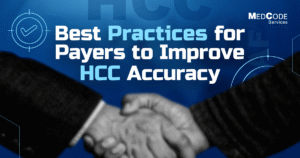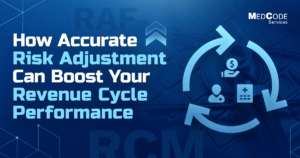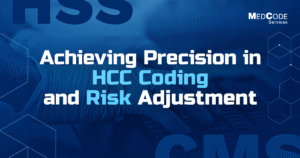Accurate Hierarchical Condition Category (HCC) coding remains a major challenge for healthcare organizations. In Fiscal Year 2024, Medicare Advantage recorded a 5.61% improper payment rate, resulting in approximately $19.07 billion in improper payments, the majority of which was tied to discrepancies in medical records or miscoded diagnoses.
Since HCC codes are central to how CMS and payers calculate risk adjustment, even small gaps in documentation or unsupported diagnoses can throw off RAF scores, putting both compliance and fair reimbursement at risk.
Explore five practical and actionable tips designed to boost HCC coding accuracy and improve RAF performance. From strengthening documentation integrity to harnessing predictive insights, each one of these tips is designed to support enhanced compliance, audit readiness, and financial impact.
Pain Points in HCC Coding Approaches
Before we dive into the tips that can aid in improving the HCC coding accuracy, it’s important to understand the major challenges that health care organizations face in practice.
Here are a few key challenges that don’t just affect the efficiency of the organization but also have a direct impact on RAF score, accuracy, and reimbursement.
a.) Incomplete or Redundant Problem Lists
Many EHR systems contain problem lists that are cluttered with either duplicate, outdated, or irrelevant entries. Poorly maintained lists force coders to sift through inconsistent data, causing missed diagnoses and coding errors that reduce accuracy and efficiency.
b.) Gaps from Missed Patient Assessments
If a patient isn’t assessed on time, it’s easy for long-term conditions to slip through without being recorded. Once that happens, the risk profile looks lighter than it really is. Lower risk adjustment scores eventually mean less payment coming back to the plan, a preventable loss caused by something as simple as a missed check-in.
MedCode helps organizations uncover such gaps through retrospective chart reviews, data-driven reporting, and coder training, ensuring that documentation aligns more closely with true patient complexity.
c). Manual and Unstructured Documentation
Many organizations still depend on manual or unstructured documentation methods, which create inconsistencies and leave room for error. These gaps not only have an effect on coding credibility but also heighten compliance risks.
MedCode supports clients by auditing documentation workflows, delivering targeted coder education, and highlighting common challenges that undermine HCC accuracy.
d). Claim Denials
Claim denials remain a significant and constant barrier linked to coding inaccuracies. As per CMS data, here are some essential publicly reported figures:
- For Qualified Health Plans (QHPs) on HealthCare.gov, nearly 19 percent of in-network claims were denied in 2023, while the denial rate for out-of-network claims climbed up to 37 percent.
- For Medicare Fee-for-Service, improper payments, often tied to coding errors or submission mistakes, stood at approximately 7.66% in FY 2024.
These figures highlight the critical importance of strong documentation, efficient coding, and compliant claim submission, not only for reducing denials but also for maintaining the integrity of reimbursement across all payer types.
e). Limited Clinician-Coder Communication
Minimal interaction between clinicians and coders leads to a disconnect in capturing the full clinical picture. Coders may be left guessing or submitting queries that often go unanswered, resulting in inaccurate data entry.
f.) Lack of Transparency into RAF Metrics
Without real-time access to RAF performance data, teams are often operating blindly. Because the information isn’t visible in time, health plans can’t easily spot or fix the bigger coding misses. That blind spot ends up creating an impact on two fronts: the revenue declines, and patient care isn’t managed as well as it should be.
Apart from the financial impact, poor coding accuracy also exposes the organizations to higher levels of compliance risks, including significantly enhanced RADV audit scrutiny and potential regulatory penalties.
g.) Insufficient Training Tied to Real-World Trends
While general coding knowledge is important, staying at par with evolving HCC models, RAF calculation rules, and CMS updates requires continuous training. Unfortunately, many training programs lack relevance to real-time data trends or fail to address the recent changes, like those introduced in HCC v28.
Fortunately, these challenges can be taken care of with ease. Innovative solution providers like MedCode are already addressing many of these barriers by offering training programs enriched with the latest regulatory updates and intelligent dashboards to monitor RAF trends at the patient and population level.
5 Actionable Tips to Drive HCC Coding Accuracy and Strengthen Risk Adjustment
Getting HCC coding right doesn’t just help with compliance; it has a direct impact on reimbursements, care planning, and how precisely patient complexity is reflected.
These are some practical as well as approachable tips that are evidence-backed and easy to implement without overhauling your entire workflow.
- Spot Hidden Gaps Through Wellness Visits
Wellness assessments often reveal chronic conditions that claims data alone may miss. For patients with chronic or multiple conditions, these wellness visits provide a chance to review existing diagnoses, refresh records, and catch new health issues early.
For payers, recognizing these gaps ensures RAF scores reflect true patient complexity. Our team at MedCode helps validate findings through chart reviews and targeted audits, reducing under-coding and misrepresented risk.
- Close Gaps with Better Clinician–Coder Communication
Breakdowns in communication between coders and providers often result in unclear or incomplete documentation, which can directly affect HCC accuracy. MedCode helps address this challenge by offering audit-driven insights and training programs that highlight documentation gaps and encourage stronger alignment between clinical narratives and coding requirements.
- Leverage Predictive Analytics to Anticipate Missed Conditions
Predictive analytics can identify members who may have conditions not yet reflected in claims or documentation. For payers, using these insights to guide retrospective audits and coding validations helps ensure patient complexity is fully captured.
- Design Training Programs with Analytical Trends and Real Data
Training never works in a one-size-fits-all way. It’s always beneficial and more efficient to design sessions around your audit findings, claim trends, and documentation gaps. When providers and coders see concrete examples from their cases, they can more easily connect the dots between everyday documentation habits and overall risk adjustment performance.
- Track RAF Score Trends and Monitor Documentation Gaps
A sudden dip in RAF scores can be taken as an early signal of missed diagnoses or weak documentation. Regularly reviewing score trends, paired with targeted record audits, allows teams to act before revenue or compliance is affected. This is especially effective when paired with clear follow-up actions for both coders and providers.
Bonus Tip: Conduct Retrospective Chart Audits
Retrospective chart reviews help discover coding gaps that might get missed in routine workflows. For payers, these audits are more than just error checks; they provide insight into how coding accuracy impacts RAF scores, reimbursement levels, and compliance. Regular reviews also aid in revealing a few crucial and recurring trends, allowing organizations to work on core issues instead of repeatedly addressing individual mistakes.
Conclusion
So far, we’ve established how, for payers, HCC coding accuracy extends beyond compliance; it drives financial stability, audit readiness, and member care.
What payers need is not a one-off fix but a structured approach that combines accurate documentation, stronger clinician-coder collaboration, predictive analytics, continuous training, and ongoing RAF monitoring.
At MedCode, we partner with healthcare organizations and work closely to improve their risk adjustment strategies. Our practical approach covers every stage, from specialized coder training and audit readiness support to smarter documentation workflows.
Connect with us today to discover how we can help you improve accuracy, stay compliant, and achieve stronger financial results.







